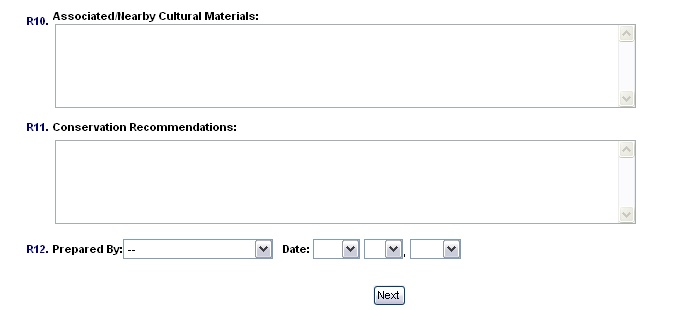Navigation: Add New Resource Wizard > Form Descriptions >
DPR523G - Rock Art Record



|
Navigation: Add New Resource Wizard > Form Descriptions > DPR523G - Rock Art Record |
  
|
A complete description of all the DPR forms is available online at this address.
The OHP Manual describes the 523G Form as:
The Rock Art Record may be used to record detailed information about individual rock art features.
Rock Art is defined as any non-portable bedrock outcrop, boulder, cave wall, or other rock surface
intentionally modified by pecking, scraping, grinding, and/or the application of pigment to form a graphic
design/image. The Rock Art Record is an optional form. It is designed to supplement the information in an
Archaeological Site Record, not to eliminate the need for its preparation. Professional surveys conducted in
advance of development activities should generally prepare a Primary Record, Location Map, and
Archaeological Site Record when a site with a rock art feature(s) is encountered. Additional information can
then be collected on a Rock Art Record if desirable.
The 523G form has the following fields:
Header Information - This includes the Primary #, HRI # and the Trinomial #. These are pre-populated (if available) from the root resource record. A box allows you to indicate the resource name or number (this is pre-populated as well).

R1 - R4 Describing the location and background - The first 4 fields describe which panel (if multiple forms are in play), the type of feature that houses the rock art (cliff, cave etc), a description of the host rock and the host background.

R5 Describe the panel

R6 Panel integrity and deterioration - There are a number of choices here to allow you to describe the overall condition of the piece and whether deterioration is a result of cultural or natural factors.

R7 Styles and suspected cultural affiliations - Describe what is known about the individuals or groups creating the art.

R8 Elements Superimposed (yes or no) - Check yes if any elements are superimposed over the art and describe by style, position and age (if known).

R9 Feature Pane Visibility - Based on accessibility and obtrusiveness, assess wether the item is visible, semi-visible or hidden from view.
![]()
R10 - R12 - the last few fields are to describe other nearby cultural artifacts or cultural residues, recommend steps for conservation and indicate the evaluator and evaluation date.

When you are finished entering data click on the "next" button.